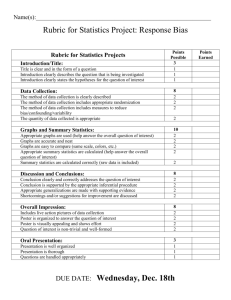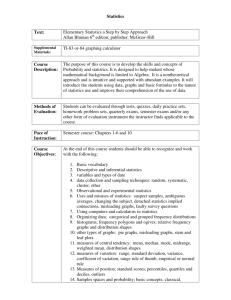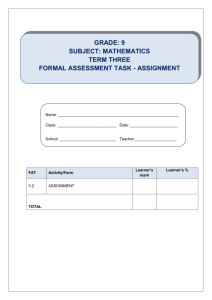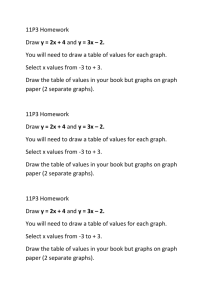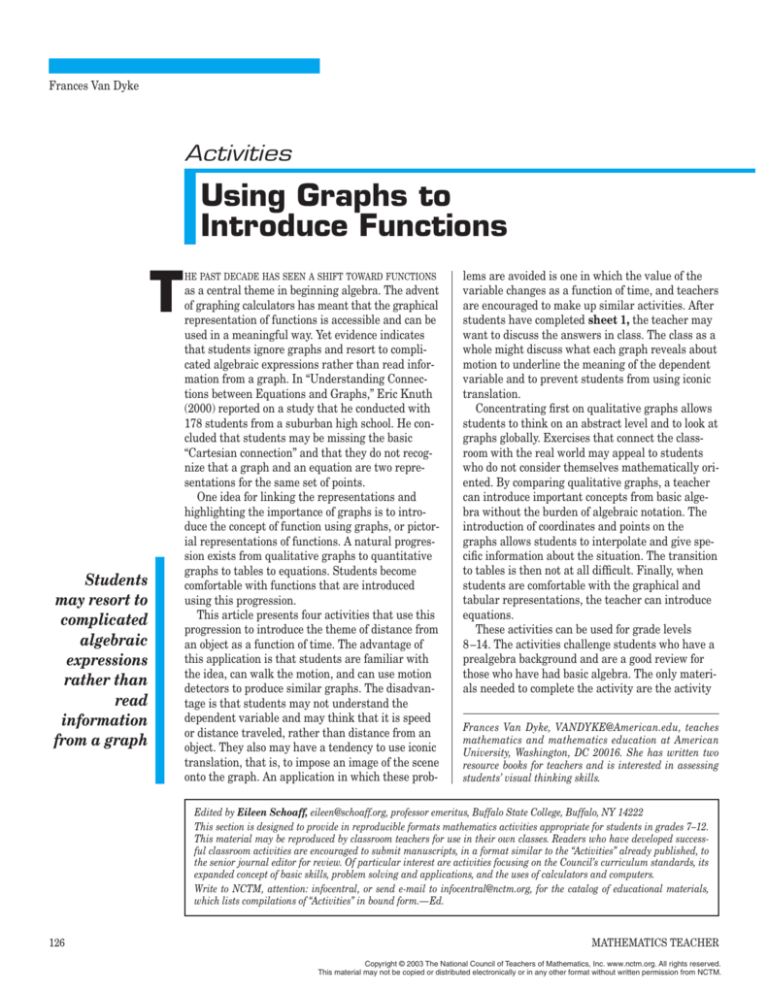
Frances Van Dyke
Activities
Using Graphs to
Introduce Functions
T
Students
may resort to
complicated
algebraic
expressions
rather than
read
information
from a graph
HE PAST DECADE HAS SEEN A SHIFT TOWARD FUNCTIONS
as a central theme in beginning algebra. The advent
of graphing calculators has meant that the graphical
representation of functions is accessible and can be
used in a meaningful way. Yet evidence indicates
that students ignore graphs and resort to complicated algebraic expressions rather than read information from a graph. In “Understanding Connections between Equations and Graphs,” Eric Knuth
(2000) reported on a study that he conducted with
178 students from a suburban high school. He concluded that students may be missing the basic
“Cartesian connection” and that they do not recognize that a graph and an equation are two representations for the same set of points.
One idea for linking the representations and
highlighting the importance of graphs is to introduce the concept of function using graphs, or pictorial representations of functions. A natural progression exists from qualitative graphs to quantitative
graphs to tables to equations. Students become
comfortable with functions that are introduced
using this progression.
This article presents four activities that use this
progression to introduce the theme of distance from
an object as a function of time. The advantage of
this application is that students are familiar with
the idea, can walk the motion, and can use motion
detectors to produce similar graphs. The disadvantage is that students may not understand the
dependent variable and may think that it is speed
or distance traveled, rather than distance from an
object. They also may have a tendency to use iconic
translation, that is, to impose an image of the scene
onto the graph. An application in which these prob-
lems are avoided is one in which the value of the
variable changes as a function of time, and teachers
are encouraged to make up similar activities. After
students have completed sheet 1, the teacher may
want to discuss the answers in class. The class as a
whole might discuss what each graph reveals about
motion to underline the meaning of the dependent
variable and to prevent students from using iconic
translation.
Concentrating first on qualitative graphs allows
students to think on an abstract level and to look at
graphs globally. Exercises that connect the classroom with the real world may appeal to students
who do not consider themselves mathematically oriented. By comparing qualitative graphs, a teacher
can introduce important concepts from basic algebra without the burden of algebraic notation. The
introduction of coordinates and points on the
graphs allows students to interpolate and give specific information about the situation. The transition
to tables is then not at all difficult. Finally, when
students are comfortable with the graphical and
tabular representations, the teacher can introduce
equations.
These activities can be used for grade levels
8–14. The activities challenge students who have a
prealgebra background and are a good review for
those who have had basic algebra. The only materials needed to complete the activity are the activity
Frances Van Dyke, VANDYKE@American.edu, teaches
mathematics and mathematics education at American
University, Washington, DC 20016. She has written two
resource books for teachers and is interested in assessing
students’ visual thinking skills.
Edited by Eileen Schoaff, eileen@schoaff.org, professor emeritus, Buffalo State College, Buffalo, NY 14222
This section is designed to provide in reproducible formats mathematics activities appropriate for students in grades 7–12.
This material may be reproduced by classroom teachers for use in their own classes. Readers who have developed successful classroom activities are encouraged to submit manuscripts, in a format similar to the “Activities” already published, to
the senior journal editor for review. Of particular interest are activities focusing on the Council’s curriculum standards, its
expanded concept of basic skills, problem solving and applications, and the uses of calculators and computers.
Write to NCTM, attention: infocentral, or send e-mail to infocentral@nctm.org, for the catalog of educational materials,
which lists compilations of “Activities” in bound form.—Ed.
126
MATHEMATICS TEACHER
Copyright © 2003 The National Council of Teachers of Mathematics, Inc. www.nctm.org. All rights reserved.
This material may not be copied or distributed electronically or in any other format without written permission from NCTM.
5. Teachers may want to have students work on
part (a) first, go over the answer, and then try
parts (b), (c), and (d). Answers should indicate
whether the people are moving toward or away
from the ride, in addition to indicating the person who is moving faster. Sample answers are as
follows.
a) Initially, Al was about twice as far from the
ride as Bea was, and he took about one-quarter
of the amount of time that she did to arrive at
the ride. Al was therefore moving eight times
as fast as Bea.
b) Intially, Clay was about four times as far from
the ride as Di. Di moved about one-half the
distance that Clay moved in three times the
time, so she was moving at six times his rate.
Di was moving away from the ride and Clay
was moving toward it.
c) Eli was initially about three times as far from
the ride as Faye was. They both reached the
ride at the same time, so Eli was traveling
three times as fast as Fay.
d) Hal was initially about half as far as Gus was
from the ride. Hal moved away, and Gus stood
still.
SOLUTIONS
Sheet 1
Distance
4.
Distance
3. The correct answer is (c). A student who thinks
that the roller coaster somehow gets pictured in
the graph might give (a) as the answer; and if
iconic translation occurs, that is, if the image of
Mary, who is standing still, imposes itself on the
graph, a person might give (d) as the answer.
Time
Time
(a)
(b)
The sharper slope in the part of (a) nearest the
vertical axis indicates that Chris’s walk toward
the tunnel was faster than his walk away from
the tunnel.
Vol. 96, No. 2 • February 2003
Sheet 2
1. The correct answer is (c).
2. a) Alisa moved 24 feet in all.
b) She took 8 seconds to walk this distance.
c) Alisa walked at the rate of 3 feet per second.
d) After 1 second, she was 21 feet away from the
pinball machine area.
e) After 2 seconds, she was 18 feet away.
f ) After 5 seconds, she was 9 feet away.
3.
(0, 8)
(24, 0)
Time
(a)
(0, 24)
(6, 0)
Time
(b)
Distance
2. Answers will vary. For graph (a), Hugo might be
standing a fixed distance from the object or moving in a circle around the object.
6. Jane’s walk is depicted in (a), Angela’s in (c), and
Kathy’s in (b). In part (a), equal distances are
covered in equal time. As time passes in (b), less
distance is covered in equal time intervals;
whereas a greater distance is covered in (c) as
time passes.
Distance
1. The correct answer is (b). A student who thinks
of the dependent variable as speed might give (a)
as the answer, and a student who thinks of the
dependent variable as distance covered might
think that (c) is the answer.
The graphs
do not
indicate
units
Although we can compare the two motions of
the members of the pairs, we have no idea how
far the people were from the rides nor how fast
they moved, since the graphs do not indicate
units. Al, Clay, Eli, and Hal were all walking
faster than Bea, Di, Faye, and Gus, respectively.
The starting point, or origin, of the walk for both
is the ride. The x-intercepts indicate time taken
for the walk; the y-intercepts indicate initial distance from the ride.
Distance
sheets and blank paper for answers. A graphing
calculator and a motion detector may also be used
to complement the activity. The objective is to help
students deepen their understanding of functions,
graphs, and the underlying equivalence of the
numeric, tabular, and algebraic representations of
functions. Students can complete the activity in
groups. Each student can keep his or her own
record of answers and can make up situations and
graphs that differ from those created by others in
the group.
Each student should keep a copy of the four
activity sheets, complete with answers, so that the
teacher can assess their work. The teacher should
discuss each sheet when students have completed
it. After students complete all four sheets, the
teacher leads the class in a discussion of the notion
of a function as a relationship between quantities
that change. The activity sheets focus on different
ways of representing this relationship. After completing the activity sheets, students write a paragraph on the aspect of the relationship that each
representation highlights. Looking at the equation
reveals initial distance, rate, and direction. A table
gives actual times with corresponding distances,
whereas a graph is best for comparing two different
motions. This progression can be developed for
other functions—both linear and nonlinear—that
students typically study.
24
8
Time
(d)
127
4. The correct answer is (c).
5. a) Hugo was 9 feet from a hot-dog stand and
inched steadily toward it, reaching it after 21
seconds. He moved at the rate of 3/7 a foot per
second.
b) Hugo was 3 feet from a hot-dog stand and
moved steadily away from it. After 9 seconds,
he was 21 feet away. He moved at a rate of 2
feet per second.
d) Hugo waited for 3 seconds, then moved away
at a rate of 3.5 feet per second. After 9 seconds, he was 21 feet away from the hot-dog
stand.
6. a) The person started 15 meters from the exit
and moved toward it at a rate of 3 meters per
second, reaching it after 5 seconds. He then
waited at the exit for 6 seconds and moved
away at a rate of 2 meters per second. Since
no indication of direction is given, he or she
could be leaving the park, entering the park,
or approaching and then backing away from
the exit.
b) The individual started 9 meters from the exit,
then moved away at a rate of 1.5 meters per
second for 4 seconds. He then returned to the
exit at a rate of 5 meters per second.
4. Entries in the tables for problem 4 on sheet 2
could be as follows:
a)
Time
0
7
14
21
Distance
9
6
3
0
b)
Time
0
1
2
3
4
9
Distance
3
5
7
9
11
21
c)
Time
0
1
2
3
Distance
9
13
17
21
d)
Time
0
1
2
3
4
5
6
7
8
9
Distance
0
0
0
0
3.5
7
10.5
14
17.5
21
Sheet 3
1. The answer is table (b). It is the only table that
shows a constant rate of change.
2. The correct answer is (c).
3. a)
128
Time
0
1
2
3
4
5
6
Distance
0
6
12
18
24
30
36
b)
Time
0
1
2
3
4
5
6
Distance
42
35
28
21
14
7
0
d)
Time
0
1
2
3
4
5
6
Distance
0
7
14
21
28
35
42
5. For problem 6 on sheet 2, the tables are as follows:
a)
Time
0
2
3
5
6
11
12
13
14
15
16
17
Distance
15
9
6
0
0
0
2
4
6
8
10
12
b)
Time
0
1
2
3
4
5
6
7
Distance
9
10.5
12
13.5
15
10
5
0
MATHEMATICS TEACHER
Sheet 4
1. The correct equation is (d). Each point in the
table satisfies the equation. The initial distance
is the y-intercept on the graph. In the table, the
initial distance is the line with 0 as the time entry.
In the equation, the initial distance the constant
term 40, which corresponds to the y-intercept.
2. a) The equation (a) y = 42 – 6x corresponds to the
table given.
b) y = 42 – 7x corresponds to table (b).
c) y = 6x corresponds to table (a).
d) y = 7x corresponds to table (d).
3. The correct answer is (b). Moving 20 feet in 8
seconds implies a rate of 2.5 feet per second,
which is the coefficient of the variable standing
for seconds elapsed. The initial distance corresponds to the constant term in the equation.
The answers will vary. For (a), one possibility
is, “Zarah was 4 feet from a stand and walked
away at 6 feet per second.” For (c), one possibility
is, “Zarah was 24 feet from a stand and walked
away at 4 feet per second.” For (d), one possibility is, “Zarah was 8 feet from a stand and walked
away at 6 feet per second.”
7. 6(a) on sheet 2:
y = 15 – 3x, if 0 < x £ 5
y = 0, if 5 < x £ 11
y = –22 + 2x, if 11 < x £ 17
6(b) on sheet 2:
y = 9 + (3/2)x, if 0 < x £ 4
y = 35 – 5x, if 4 < x £ 7
BIBLIOGRAPHY
Knuth, Eric. “Understanding Connections between
Equations and Graphs.” Mathematics Teacher 93
(January 2000): 48–53.
Koellner-Clark, Karen, L. Lynn Stallings, and Sue A.
Hoover. “Socratic Seminars for Mathematics.” Mathematics Teacher 95 (December 2002): 682–87.
National Council of Teachers of Mathematics (NCTM).
Principles and Standards for School Mathematics.
Reston, Va.: NCTM, 2000.
Van Dyke, Frances. A Visual Approach to Functions.
Emeryville, Calif.: Key Curriculum Press, 2002. ‰
(Worksheets begin on page 130)
4. The correct answer is (d). The rate of 3 feet per
second is the absolute value of the coefficient of
the variable standing for seconds elapsed. The
coefficient is negative when Josh is walking
toward the bumper cars, so his distance from
them decreases as time passes. The initial distance of 30 feet corresponds to the constant term
in the equation.
For (a), one possibility is, “A man in a car was
3 feet from a sign, and he rode away at a rate of
30 feet per second.” For (b), one possibility is,
“An object was 3 feet above sea level and dropped
down at a rate of 30 feet per second.” For (c), one
possibility is, “A man was 30 feet from a sign and
walked away at a rate of 3 feet per second.”
5. The rate of motion is positive when the individual is moving away from the object, and it is negative when he or she is moving toward the object.
The distance is increasing (positive) when the
individual is moving away from the object, and it
is decreasing (negative) when the individual is
moving toward the object. The rate of motion is
the slope of the line on the graph. The rate of
motion can be determined in the table by the difference in distance for each increment in time,
that is, difference in distance divided by difference in time.
6. a) y = 9 – (3/7)x
b) y = 3 + 2x
c) y = 9 + 4x
d) y = –10.5 + (7/2)x
Vol. 96, No. 2 • February 2003
129
USING GRAPHS TO INTRODUCE FUNCTIONS
SHEET 1A
Each of the graphs on this page represents distance from an object as a function of time.
distance
distance
distance
distance
1. On the following graphs, distance, as labeled on the y-axis, refers to distance from an amusement park. Which graph best matches the following sentence?
Hugo walked at a steady pace toward the amusement park.
time
time
time
time
(a)
(b)
(c)
(d)
2. Describe a situation involving distance and time that could match each of the graphs that you
did not choose as the answer to problem 1.
distance
distance
distance
distance
3. In this problem, distance on the y-axis stands for Mary’s distance from the roller-coaster
entrance. Which graph best matches the following sentence?
While she was standing still, Mary looked at the roller-coaster track in the distance.
time
time
time
time
(a)
(b)
(c)
(d)
•
4. Draw a graph that could correspond to each of the following situations. For graph (a), let the
y-axis represent distance from the tunnel of love. For graph (b), let the y-axis represent distance
from the entrance to the Ferris wheel.
a) Chris walked quickly toward the tunnel of love and then slowly walked away from it.
b) We stood for a while, and then the line in which we were waiting began to slowly move
toward the Ferris wheel.
From the Mathematics Teacher, February 2003
USING GRAPHS TO INTRODUCE FUNCTIONS—Continued
SHEET 1B
C
E
F
distance
B
D
distance
A
distance
distance
5. Each of the following graphs depicts the relationship between distance from a ride and time
elapsed for two people. Each person walks at a steady rate directly toward or away from the
ride or stands still. For each graph, describe the relationships and make observations and
comparisons.
G
H
time
time
time
time
(a)
(b)
(c)
(d)
In addition to your observations, answer the following questions for each example:
Which person is walking faster?
What is the significance of the x-intercept? The y-intercept?
distance
distance
distance
6. The graphs below show motion away from the park for three different mothers. Jane moves at a
steady pace, Angela speeds up as she walks away, and Kathy slows down as she moves away.
Which graph matches which woman’s motion? Explain your reasoning.
time
time
time
(a)
(b)
(c)
From the Mathematics Teacher, February 2003
USING GRAPHS TO INTRODUCE FUNCTIONS
SHEET 2A
distance
1. Consider the graph below, in which time in seconds is graphed along the x-axis and distance in
feet is graphed along the y-axis. The graph shows Alisa’s distance from the pinball machine
area as a function of time. Which sentence is a good match for the graph?
a) Alisa stood 8 feet from the pinball machine area and
moved toward it, reaching it after 24 seconds.
(0, 24)
b) Alisa stood 24 feet from the pinball machine area and
moved toward it at a rate of 4 feet per second.
c) Alisa stood 24 feet from the pinball machine area and
moved toward it, reaching it after 8 seconds.
d) Alisa stood 8 feet from the pinball machine area and
(8, 0)
moved away from it, stopping when she was 24 feet away.
time
2. a) How many feet did Alisa move in all? ________________________________________________
b) How long did she take to walk this distance? __________________________________________
c) The straight line indicates a steady pace. How many feet did Alisa walk in each second? ______
d ) How far was Alisa from the area after 1 second? ______________________________________
e) How far was Alisa from the area after 2 seconds? _____________________________________
f ) How far was Alisa from the area after 5 seconds? _____________________________________
3. For each answer not chosen in question 1, sketch a graph that could correspond to that
description. Write the description next to your graph.
From the Mathematics Teacher, February 2003
USING GRAPHS TO INTRODUCE FUNCTIONS—Continued
SHEET 2B
4. Hugo was standing 9 feet from the hot-dog stand. He walked away, and after 3 seconds he was
21 feet away. Which of the following graphs corresponds to this situation?
(9, 21)
(0, 3)
time
(0, 9)
time
(9, 21)
distance
(21, 0)
(3, 21)
distance
distance
distance
(0, 9)
(3, 0)
time
time
5. Write a description, similar to the one given in problem 1, that could correspond to each of the
graphs not chosen in question 4. Determine the walking rate in each situation.
distance
(0, 15)
(5, 0)
(17, 12)
(11, 0)
distance
6. In the following two graphs, distance in meters from the main exit is graphed as a function of
time in seconds for one individual. Describe the motion using the coordinates shown as endpoints of the line segments. Determine the rate at which the person walks for each segment.
Assume that the person is moving directly toward or away from the exit that or he or she is
standing still.
(4, 15)
(0, 9)
time
time
(a)
(b)
(7, 0)
From the Mathematics Teacher, February 2003
USING GRAPHS TO INTRODUCE FUNCTIONS
SHEET 3A
Time
0
2
4
6
8
Distance
24
16
18
10
10
(a)
Time
0
2
4
6
8
Distance
24
18
12
16
10
(b)
Time
0
2
4
6
8
Distance
24
18
11
13
10
(c)
(0, 24)
distance
1. Consider again the graph at the right, where time in seconds is
graphed along the x-axis and distance in feet is graphed along
the y-axis. The graph shows Alisa’s distance from a pinball
machine area as a function of time. Which table describes the
graph? Explain your decision.
(8, 0)
time
2. Consider the following table.
Time
0
1
2
3
4
5
6
7
Distance from Water Ride
42
36
30
24
18
12
16
10
Choose the sentence that best describes the table.
a) Kirk walked away from the water ride at a rate of 6 feet per second.
b) Kirk was 42 feet away from the water ride and walked toward it at a rate of 7 feet per second.
c) Kirk was 42 feet away from the water ride and walked toward it at a rate of 6 feet per second.
d) Kirk walked away from the water ride at a rate of 7 feet per second.
From the Mathematics Teacher, February 2003
USING GRAPHS TO INTRODUCE FUNCTIONS—Continued
SHEET 3B
3. For each answer that did not describe the table in question 2, make a table that could correspond to it. Give entries for each second from 0 to 6.
4. Make tables that correspond to the graphs given on sheet 2, question 4.
5. Make tables that correspond to the graphs on sheet 2, question 6.
From the Mathematics Teacher, February 2003
USING GRAPHS TO INTRODUCE FUNCTIONS
SHEET 4A
Time
0
2
4
6
8
a) y = 40x – 8
Distance
40
30
20
10
0
b) y = 40 – 8x
c) y = 5x + 40
(0, 40
distance
1. Consider the graph at the right, where time in seconds is
graphed along the x-axis and distance in feet is graphed along
the y-axis. The graph shows a girl’s distance from a spaceship
ride as a function of time. A table of values that could accompany the graph is also given. Use the table to help you decide
which equation matches the graph.
(8, 0)
time
d) y = 40 – 5x
Explain why you made your choice.
How is the initial distance indicated on the graph? In the table? In the equation?
2. Consider again the sentences created on sheet 3, question 2, and the tables created in question 3.
Each of the following is an equation that describes one and only one of the sentences. Here,
x corresponds to time in seconds and y to distance in feet. Write the appropriate sentence
under each equation. Indicate the table that goes with each equation. Does each pair of values
in the tables satisfy the equation?
a) y = 42 – 6x
b) y = 42 – 7x
c) y = 6x
d) y = 7x
From the Mathematics Teacher, February 2003
USING GRAPHS TO INTRODUCE FUNCTIONS—Continued
SHEET 4B
3. Zarah is standing 4 feet from a concession stand. She walks away at a steady pace. After 8 seconds, she is 24 feet away. Choose the linear equation that indicates her distance, y, from the stand
as a function of time elapsed in seconds, x, since Zarah began walking. Explain your reasoning.
b) y = 4 + 2.5x
c) y = 24 + 4x
d ) y = 8 + 6x
a) y = 4 + 6x
For each answer not chosen, give a scenario that describes the equation.
4. Josh is 30 feet from the bumper cars. He walks toward them at the rate of 3 feet per second.
Choose the linear equation that describes the distance from the bumper cars as a function of
time elapsed, x, in seconds. Explain your reasoning.
b) y = 30 + 3x
c) y = 3 – 30x
d ) y = 30 – 3x
a) y = 30x + 3
For each answer not chosen, describe a situation that corresponds to the equation.
5. Notice that the equation can always be written in the following form: Distance after x seconds
equals initial distance ± rate of motion times x. When is the sign positive, and when is it negative? Explain why. What indicates rate of motion in the graph? In the table?
6. Determine the equations for the graphs given in problem 4 on sheet 2. Be sure that the table
entries that you gave on sheet 3, question 4, satisfy the appropriate equations.
7. Challenge: Find the equations for the graphs given in question 6 on sheet 2. These graphs consist of more than one line segment, so give the interval for each equation. (For example, a possible answer might be 2x + 1 for 0 £ x £ 3. Be sure that the table entries that you gave on sheet
3, question 5, satisfy the equations for the given intervals.
From the Mathematics Teacher, February 2003






